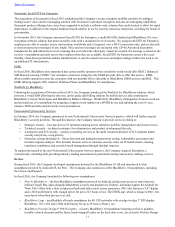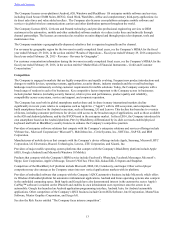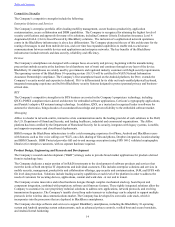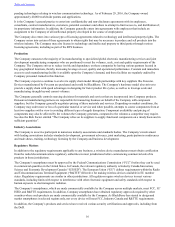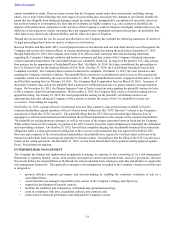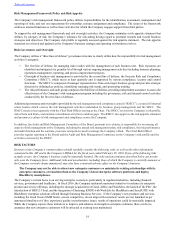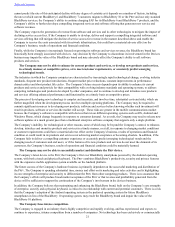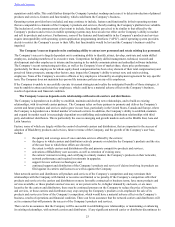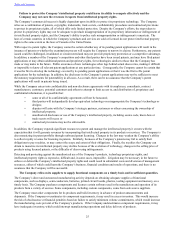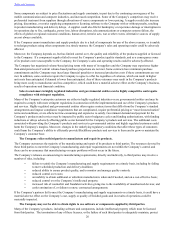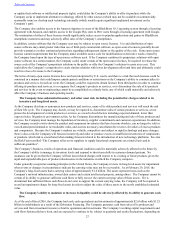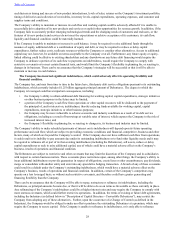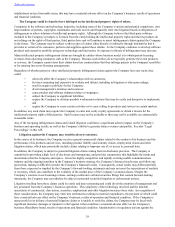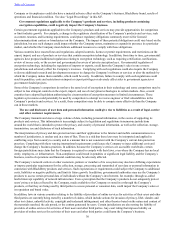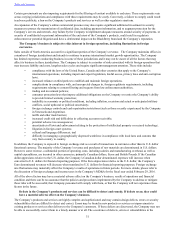Blackberry 2016 Annual Report Download - page 30
Download and view the complete annual report
Please find page 30 of the 2016 Blackberry annual report below. You can navigate through the pages in the report by either clicking on the pages listed below, or by using the keyword search tool below to find specific information within the annual report.
Table of Contents
21
cannot predict the rate of this anticipated decline with any degree of certainty as it depends on a number of factors, including
the rate at which current BlackBerry 6 and BlackBerry 7 customers migrate to BlackBerry 10 or the PRIV and use only standard
BlackBerry services, the Company’s ability to continue charging SAF for its BlackBerry 6 and BlackBerry 7 products, and the
Company’s ability to further develop a compelling integrated services and software offering that generates new service and
software revenues.
The Company expects the generation of revenue from software and services and its other technologies to mitigate the impact of
declining service access fees. If the Company is unable to develop, deliver and support a compelling integrated software and
services offering that will mitigate the decline of service access fee revenue in the manner described above and enable the
Company to recover the costs associated with its network infrastructure, this could have a material adverse effect on the
Company’s business, results of operations and financial condition.
Finally, while the Company is increasingly focused on growing its software and services revenue, the BlackBerry brand has
historically been strongly associated with devices. Any decision by the Company to discontinue its involvement in the Devices
business may impair the value of the BlackBerry brand and may adversely affect the Company’s ability to sell software
products and services.
The Company may not be able to enhance its current products and services, or develop new products and services,
in a timely manner, at competitive prices, or to meet customer requirements, or accurately predict emerging
technological trends.
The industries in which the Company competes are characterized by increasingly rapid technological change, evolving industry
standards, frequent new product introductions, frequent market price reductions, constant improvements in performance
characteristics and short product life cycles. The Company’s future success depends upon its ability to enhance its current
products and services and provide for their compatibility with evolving industry standards and operating systems, to address
competing technologies and products developed by other companies, and to continue to develop and introduce new products
and services offering enhanced performance and functionality on a timely basis at competitive prices.
The process of developing new technology is complex and uncertain, and involves time, substantial costs and risks, which are
further magnified when the development process involves multiple operating platforms. The Company may be required to
commit significant resources to developing new products, software and services before knowing whether such investment will
result in products, software or services the market will accept. These risks are greater in the mobile communications market
because the Company’s software is compatible with devices that run on different operating systems such as iOS, Android and
Windows Phone, which change frequently in response to consumer demand. As a result, the Company may need to release new
software updates at a much greater pace than a traditional enterprise software company that supports only a single platform.
The Company’s inability, for technological or other reasons, some of which may be beyond the Company’s control, to enhance,
develop, introduce and monetize products and services in a timely manner, or at all, in response to changing market conditions
or customer requirements could have a material adverse effect on the Company’s business, results of operations and financial
condition or could result in its products and services not achieving market acceptance or becoming obsolete. In addition, if the
Company fails to deliver a compelling customer experience or accurately predict emerging technological trends and the
changing needs of customers and end users, or if the features of its new products and services do not meet the demands of its
customers, the Company’s business, results of operations and financial condition could be materially harmed.
The Company may not be able to successfully market and distribute the PRIV device.
The Company’s latest device is the PRIV, the Company’s first ever BlackBerry smartphone powered by the Android operating
system, with both a touch and physical keyboard. The PRIV combines BlackBerry’s productivity, security and privacy features
with the expansive mobile application system available on the Android platform.
The future success of the Company’s hardware business is primarily dependent on the successful marketing and distribution of
the PRIV. The Company is spending substantial time, money and effort on its marketing and sales activities and is highlighting
its core strengths of enterprise and security to differentiate the PRIV from other competing products. There is no assurance that
the Company’s efforts will produce broad market acceptance of the PRIV or that revenue and profitability generated from the
device will be sufficient to support the continuation of the Company’s involvement in the devices business.
In addition, the Company believes that maintaining and enhancing the BlackBerry brand, built on the Company’s core strengths
of enterprise, security and a physical keyboard, is critical to its relationship with current and potential customers. There is a risk
that the Company’s adoption of the Android operating system as the preferred operating system for future BlackBerry
smartphones in lieu of the BlackBerry 10 operating system, may erode the BlackBerry brand and impair the value of the
BlackBerry 10 platform.
The Company faces intense competition.
The Company is engaged in an industry that is highly competitive and rapidly evolving, and has experienced, and expects to
continue to experience, intense competition from a number of companies. No technology has been exclusively or commercially


